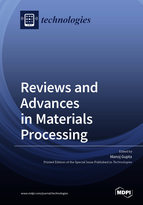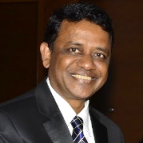Reviews and Advances in Materials Processing
A special issue of Technologies (ISSN 2227-7080). This special issue belongs to the section "Innovations in Materials Processing".
Deadline for manuscript submissions: closed (31 December 2021) | Viewed by 79948
Special Issue Editor
Interests: metal additive manufacturing; processing; characterization; lightweight materials; nanocomposites
Special Issues, Collections and Topics in MDPI journals
Special Issue Information
Dear Colleagues,
Materials processing is the first, and a key, step in proper utilization of the composition of a given material and to realize the microstructural features that are intended to attain desired property levels for a given application. Both primary and secondary processing methods are equally important in tailoring the end properties of materials. In view of the crucial importance of the processing of materials, this Special Issue is intending to cover all innovative aspects of primary processing (solid phase, liquid phase, two phase, 3D printing, rapid solidification, etc.) and secondary processing (such as variations in extrusion, forging, rolling, equichannel angular extrusion, etc.) of materials (polymers/ metal/ceramic-based, including their composites). Desirable attributes expected for submission will be processing–microstructure–property interrelations.
Prof. Dr. Manoj Gupta
Guest Editor
Welcome to leave your comments in the Discussion Group for this Special Issue.
Manuscript Submission Information
Manuscripts should be submitted online at www.mdpi.com by registering and logging in to this website. Once you are registered, click here to go to the submission form. Manuscripts can be submitted until the deadline. All submissions that pass pre-check are peer-reviewed. Accepted papers will be published continuously in the journal (as soon as accepted) and will be listed together on the special issue website. Research articles, review articles as well as short communications are invited. For planned papers, a title and short abstract (about 100 words) can be sent to the Editorial Office for announcement on this website.
Submitted manuscripts should not have been published previously, nor be under consideration for publication elsewhere (except conference proceedings papers). All manuscripts are thoroughly refereed through a single-blind peer-review process. A guide for authors and other relevant information for submission of manuscripts is available on the Instructions for Authors page. Technologies is an international peer-reviewed open access monthly journal published by MDPI.
Please visit the Instructions for Authors page before submitting a manuscript. The Article Processing Charge (APC) for publication in this open access journal is 1600 CHF (Swiss Francs). Submitted papers should be well formatted and use good English. Authors may use MDPI's English editing service prior to publication or during author revisions.
Keywords
- primary processing
- secondary processing
- metals
- polymers
- ceramics
- composites






